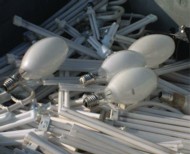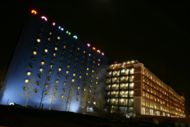Making light of maintenance costs

By prolonging the life of lamps, lighting control reduces the problem of their disposal.
There are more benefits to be gained from controlling lighting than energy savings. The reductions in maintenance costs can be even more important. Mark Andrew explains how good lighting control can help slash maintenance costs.In many projects where lighting controls are being specified there will usually be a core of people who fully understand the energy savings benefits of such systems and, for them, installing lighting controls will be a ‘no brainer’. Very often, though, the person making the ultimate decisions — particularly in refurbishment or retrofit projects — will be a hard-nosed financial person whose only interest in life is getting a good return on investment. Such people are not interested in airy fairy notions like climate change or carbon footprint; they want to deal in facts and figures.
Total costs That is why it is so important to take everything into account when calculating the real costs of a lighting-control system. Not only should the capital cost of the kit and the cost of the contractor installing it be considered, but also the ongoing costs through the life of the installation — with a comparison of projected costs, with and without lighting controls. In particular, there can be substantial savings on maintenance costs and on lamp disposal costs at the end of their life. Fundamentally, lighting controls are about ensuring that lighting is not used when it is not needed; we all know that. And as a result of this reduced usage, lamps will last longer and need changing less frequently; again this is fairly obvious. A further extension in lamp life may be achieved by running fluorescent lamps at less than 100% output initially, using a dimming control, and then gradually increasing the percentage output as the lamp gets older and light output falls off. When linked with photocells, this approach ensures that light levels are maintained while maximising the life of the lamps. The important thing is to consider the full extent of the relationship between lamp life and maintenance costs — which goes far beyond the cost of buying a new lamp. For example, under Working at Height Regulations 2005 the use of even a small step ladder requires a risk assessment to be carried out and documented. The area where the work is carried out will also need to be cordoned off. All this increases the cost of maintaining lighting because it takes longer to perform each task and generates considerably more paperwork. It becomes particularly costly in areas where lighting is mounted high and requires specialist equipment for access. Many such areas will be warehouses, factories or retail ‘sheds’, where lighting maintenance work may also disrupt the core activities within the space, adding further to the cost.
Lamp disposal In addition, disposing of the old lamps after re-lamping is now subject to higher costs since the implementation of the WEEE (Waste Electrical & Electronic Equipment) Directive. Under this directive, all discharge lamps (fluorescent, sodium, metal halide, mercury etc.) have to be sent for recycling using a specialist contractor. Extending the life of lamps through effective control therefore helps to reduce these costs simply by reducing the number of lamps disposed of each year.
 |
A major benefit of the installation of lighting control based on CP ceiling-mounted PIR presence detectors is longer lamp life, resulting in extended relamping cycles and reduced maintenance costs. There are also fewer lamps to dispose of. |
A case in point is the lighting control at Fort Dunlop, where ceiling-mounted presence detectors from CP Electronics are used extensively to provide precise control over lighting zones and reduce the overall cost of ownership of the lighting installation. Increasingly, organisations are turning to group lamp replacement to take advantage of economies of scale, replacing all the lamps in a building or area in one operation. To be truly cost-effective, group replacement needs to be carried out as close as possible to the end of the life of the lamps, but before they start to fail in large numbers. Using a lighting-control system that incorporates addressable ballasts and can monitor the condition and status of the lamps and feed that information back to a central PC helps to turn group replacement from a ‘fine art’ to a precise science. Such a system will also make it much easier and less costly to reconfigure the lighting through the software when layouts in the space change — so there is less need to change hard wiring. Lighting controls have also brought about major savings on the cost of monitoring and testing emergency lighting for many organisations. A few years ago the only way to do this was to have staff walking around the entire building to ensure the emergency lighting was working. Now, with automated emergency-lighting systems, this testing can be carried out automatically and fully documented — all from a remote location.
Holistic view Taking an holistic view of the total costs of running and lighting installation and all the benefits of controlling that lighting effectively makes it very clear that lighting controls pay their way very quickly. If this approach were taken in more projects there might be fewer instances where the control element is diluted or dropped altogether simply to reduce capital costs.
Mark Andrew is with CP Electronics.
Related links:









